
Thalassocnus is an extinct genus of semiaquatic ground sloths from the Miocene and Pliocene of the Pacific South American coast. It is monotypic within the subfamily Thalassocninae. The five species—T. antiquus, T. natans, T. littoralis, T. carolomartini, and T. yuacensis—represent a chronospecies, a population gradually adapting to marine life in one direct lineage. They are the only known aquatic sloths, but they may have also been adapted to a terrestrial lifestyle. They have been found in the Pisco Formation of Peru, the Tafna Formation of Argentina, and the Bahía Inglesa, Coquimbo, and Horcón formations of Chile. Thalassocninae has been placed in both the families Megatheriidae and Nothrotheriidae.
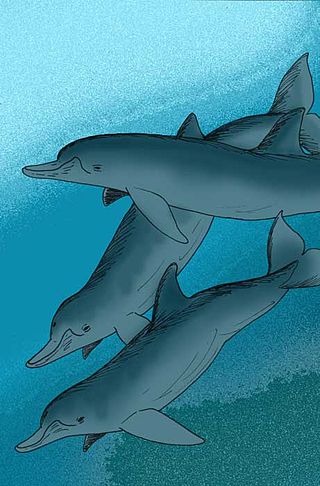
Australodelphis mirus is an extinct Pliocene dolphin. A. mirus is known from fossils found in the Sørsdal Formation, Mule Peninsula, Vestfold Hills, East Antarctica. The genus has been described as an example of convergent evolution with beaked whales.
The South American land mammal ages (SALMA) establish a geologic timescale for prehistoric South American fauna beginning 64.5 Ma during the Paleocene and continuing through to the Late Pleistocene. These periods are referred to as ages, stages, or intervals and were established using geographic place names where fossil materials where obtained.
The Laventan age is a period of geologic time within the Middle Miocene epoch of the Neogene, used more specifically within the SALMA classification in South America. It follows the Colloncuran and precedes the Mayoan age.
The Mayoan age is a period of geologic time from 11.8 to 10 Ma, within the Middle to Late Miocene epoch of the Neogene, used more specifically within the SALMA classification in South America. It follows the Laventan and precedes the Chasicoan age.
The Chasicoan age is a period of geologic time from 10–9 Ma within the Late Miocene epoch of the Neogene, used more specifically within the SALMA classification in South America. It follows the Mayoan and precedes the Huayquerian age.
The Huayquerian age is a period of geologic time within the Late Miocene epoch of the Neogene, used more specifically within the SALMA classification. It follows the Chasicoan and precedes the Montehermosan age.

Livyatan is an extinct genus of macroraptorial sperm whale containing one known species: L. melvillei. The genus name was inspired by the biblical sea monster Leviathan, and the species name by Herman Melville, the author of the famous novel Moby-Dick about a white bull sperm whale. Herman Melville often referred to whales as "Leviathans" in his book. It is mainly known from the Pisco Formation of Peru during the Tortonian stage of the Miocene epoch, about 9.9–8.9 million years ago (mya); however, finds of isolated teeth from other locations such as Chile, Argentina, the United States (California), South Africa and Australia imply that either it or a close relative survived into the Pliocene, around 5 mya, and may have had a global presence. It was a member of a group of macroraptorial sperm whales and was probably an apex predator, preying on whales, seals and so forth. Characteristically of raptorial sperm whales, Livyatan had functional, enamel-coated teeth on the upper and lower jaws, as well as several features suitable for hunting large prey.
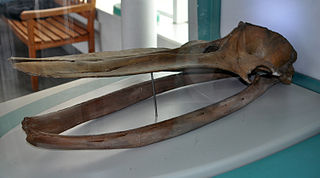
Piscobalaena is an extinct genus of cetaceans, which lived from the Middle to Late Miocene epochs in Peru and Florida. Its fossils have been found in the Pisco Formation of Peru and the Bone Valley Formation of Florida. At least some individuals of this diminutive whale were preyed on by the shark O. megalodon.
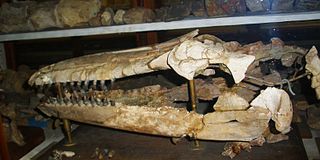
Hemisyntrachelus is an extinct genus of cetacean.
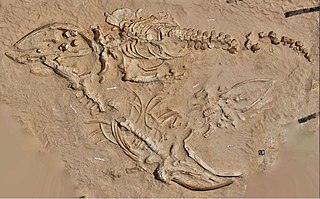
Cerro Ballena is a fossiliferous locality of the Bahía Inglesa Formation, located in the Atacama Desert along the Pan-American Highway a few kilometers north of the port of Caldera, Chile. It has been dated back to the Late Miocene epoch, during the Neogene period. The locality was first noted in 1965 during military work and fully excavated and studied between 2011 and 2012, and is protected by law since the latter year.

The Pisco Formation is a geologic formation located in Peru, on the southern coastal desert of Ica and Arequipa. The approximately 640 metres (2,100 ft) thick formation was deposited in the Pisco Basin, spanning an age from the Late Miocene up to the Early Pliocene, roughly from 9.6 to 4.5 Ma. The tuffaceous sandstones, diatomaceous siltstones, conglomerates and dolomites were deposited in a lagoonal to near-shore environment, in bays similar to other Pacific South American formations as the Bahía Inglesa and Coquimbo Formations of Chile.
Caldera Basin is a sedimentary basin located in the coast of northern Chile west of Copiapó. The basin has a fill of marine sediments of Late Cenozoic age. With a north–south extension of 43 kilometres (27 mi) and an east–west width of 20 kilometres (12 mi) the basin occupies an area between the coast and the Chilean Coast Range and between the port of Caldera and the mouth of Copiapó River. The sedimentary fill rests on metamorphic rocks of Paleozoic age and on plutonic rocks of Mesozoic age.
Notocetus is an extinct genus of river dolphin belonging to Squalodelphinidae. Known specimens have been found in Early Miocene marine deposits from Argentina, Italy and Peru.

Brachydelphis is a genus of pontoporiid known from the Late Miocene Pisco Formation of Peru and the Bahía Inglesa Formation of Chile.
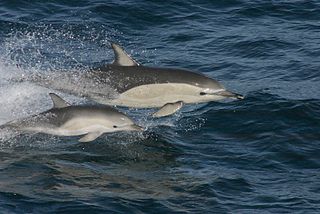
Delphinida is a clade of cetaceans in the parvorder Odontoceti, the toothed whales. It includes all modern oceanic dolphins, porpoises, and their relatives, such as Lipotidae and Iniidae.
Pisco Basin is a sedimentary basin extending over 300 kilometres (190 mi) in southwestern Peru. The basin has a 2 kilometres (6,600 ft) thick sedimentary fill, which is about half the thickness of more northern foreland basins in Peru.

Spheniscus muizoni is an extinct species of banded penguins that lived during the early Late Miocene in what is now Peru, South America. The species, the earliest member of the extant genus, was described in 2007 by Ursula B. Göhlich based on fossils found in the fossiliferous Pisco Formation of the Pisco Basin, southwestern Peru.

The Gaiman Formation, in older literature also referred to as Patagonian Marine Formation, is a fossiliferous geologic formation of the Peninsula Valdés Basin in the eastern Chubut Province of northwestern Patagonia, eastern Argentina.











